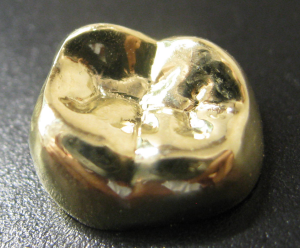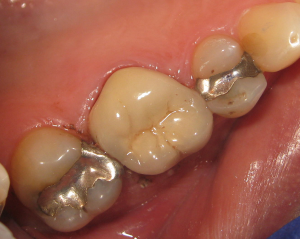A dental crown is a tooth-shaped “cap” that is placed on a tooth or implant to cover the tooth to restore its shape and size, strength, and improve its appearance and aesthetic.
Crowns are one of the more common dental restorations that patient need on their teeth, most dentist are regularly asked the same question, “Do I really need to get a crown The reason they are recommended frequently is that a dental crown is often the best and durable option to extend the life of a tooth.
At Aquarius Dental, we evaluate all options and review them with you before recommending a crown or set of crowns.
Six Things You Should Ask Your Dentist Before Getting A Crown
1. Show me and tell me why a cap is needed for my tooth.
If it hurts when you bite down, especially when you release your jaw it is possible that your tooth is cracked or split. If a tooth is cracked, it is a serious condition that require a crown or partial occlusal coverage. The crack cannot heal on its own and will progress and worsen which may cause the symptoms to become more intense over time and you might need a root canal treatment additional to the crown. In some situation the tooth can split in half and it has to be extracted.
However, tooth can have craze line which are very common and not harmful. Most every adult back tooth has craze lines. These are just simple stress lines that do not necessarily indicate a crown.
2. What are my options instead of the crown?
In some cases, while a cap is one option, there can be other treatment options possible. You might opt for a filling instead. But filling does not prevent you from needing a crown later on. Also, if a large portion of your tooth needs filling, a better solution is usually the crown because fillings do not give you the same protection as crowns do. Also, if the filling is big, it can cause the tooth to break, making it irreparable.
3. What are the implications of waiting?
-Nothing might happen.
-The tooth could chip- simple repair. Or it could crack and would need a crown.
-In rare cases waiting could cause a root canal to be needed.
-The tooth could split, which could require crown lengthening or extraction.
These are things that your dentist should answer.
4. Is a Root Canal needed before getting a crown?
In doing crown most teeth do not need root canals before the prep. However sometimes teeth can die over time and may need root canal. If a tooth is not infected or acutely inflamed, it will not need a root canal.
5. Does an old, really large silver filling mean I need a crown?
If a silver filling is 2/3 the width of the tooth or more, it may require a cap.
6. What are my options for the material of the crown
Stainless steel crowns are pre-made crowns that are used on permanent or baby teeth primarily as a temporary measure. The crown protects the tooth or filling while a permanent crown is made from another material. For children, a stainless steel crown is commonly used to fit over a primary tooth that’s been prepared to fit it. The crown covers the entire tooth and protects it from further decay. When the primary tooth exfoliates, the crown comes out naturally with it. In general, stainless steel crowns are used for children’s teeth because they don’t require multiple dental visits to put in place and so are more cost- effective than custom-made crowns. They simply hold the space for the future permanent tooth. If the baby teeth are not properly restored, other teeth may shift and child could need orthodontic treatment to move the crooked teeth to the original location and create enough room for the permanent tooth.
Metals used in crowns include gold alloy, other alloys (for example, palladium), or no precious (for example, nickel or chromium). Compared with other crown types, less tooth structure needs to be removed with metal crowns, and tooth wear to opposing teeth is kept to a minimum if we use high Gold alloys. Metal crowns withstand biting and chewing forces well and probably last the longest in terms of wear down. Also, metal crowns rarely chip or break. The metallic color is the main disadvantage. Metal crowns are a good choice for back molars.

Porcelain-fused-to-metal dental crowns can be color matched to your adjacent teeth (unlike the metallic crowns). However, more wearing to the opposing teeth occurs with this crown type compared with metal or resin crowns. The crown’s porcelain portion can also chip or break off if the patient is a grinder or bruxer. Next to all-ceramic crowns, porcelain-fused-to-metal crowns look most like normal teeth. However, sometimes the metal underlying the crown’s porcelain can show through as a dark line, especially at the gum line and even more so if your gums recede. These crowns can be a good choice for front or back teeth.

All-ceramic or all-porcelain dental crowns provide the best natural color match than any other crown type and may be more suitable for people with metal allergies. However, they are not as strong as porcelain-fused-to-metal crowns. All-ceramic crowns are a good choice for front teeth.
A dental crown may be needed in the following situations:
To protect a weak tooth (for instance, from decay) from breaking or to hold together parts of a cracked tooth
To restore an already broken tooth or a tooth that has been severely worn down
To cover and support a tooth with a large filling when there isn’t a lot of tooth left
To hold a dental bridge in place
To cover severely discolored teeth
To cover a dental implant
To make a cosmetic modification
For children, a crown may be used on primary (baby) teeth in order to:
Save a tooth that has been so damaged by decay that it can’t support a filling.
Protect the teeth of a child at high risk for tooth decay, especially when a child has difficulty keeping up with daily oral hygiene.
What is a crown?
A crown is an dental restoration that fits over the remaining part of a prepared tooth, making it strong and giving it the shape of a natural tooth. A crown is sometimes known as a ‘cap’.
How is a crown prepared?
The dentist will prepare the tooth so it is the ideal shape for the crown. This will involve removing some of the outer surface, and leaving a strong inner core. The amount of the tooth removed will be the same as the thickness of the crown. Once the tooth is shaped, the dentist will take an impression or mould of the prepared tooth, one of the other jaw, and possibly another to mark the way you bite together.
The impressions will then be given to the dental technician, along with details of the shade to use and other information needed for the crown to be made.
What will happen between visits?
Your dentist will fit a temporary cap so that you can use the tooth while you wait for the crown to be made. You will this temporary only for 1 or 2 weeks.
How is the crown fitted?
When you and your dentist are happy with the fit and appearance of the new crown it will be fixed in place with special dental cement or adhesive. The cement forms a seal to hold the crown in place.
How long does the treatment take?
You will need to have at least two visits. The first is to have the tooth prepared, the impressions taken, the shade matched and the temporary crown fitted. The second is to fit the permanent crown. There will usually be about 1 to 2 weeks in between appointments.
Does it hurt to have a tooth prepared for a crown?
No, you will have a local anaesthetic or freezing and the preparation should feel no different from a filling. The prepped tooth could become sensitive to cold for couple days. Very small percentage of the capped teeth may require root canal treatment due to the extent of the decay or remaining tooth structure.
Will the crown be noticeable?
In Aquarius dental we send some patients to do custom shading in the dental technician lab. Whit this method we can get the excellent results, alternatively we can take some intra oral photos from the tooth and email them to the same lab. The crown will be made to match your other teeth as closely as possible. The shade of the neighbouring teeth will be recorded, to make sure that the colour looks natural and matches the surrounding teeth. There are some drawback for some of the dental materials with regards to the shade match for instance it is very difficult to achieve very esthetic results with porcelain fused to metal caps.
Will the crown feel different?
Because the shape of the crown will be slightly different from the shape of your tooth before it was crowned, you may be aware of it to begin with. Within a few days it should feel fine, and you will not notice it. The crown may need some adjustment if your bite does not feel comfortable. If so, you should ask your dentist to check and adjust it.
What will it cost?
Costs will vary depending on the type of crown and the material used. It is a good idea to get a written estimate and treatment plan before beginning any dental treatment.
How do I care for my crown?
How long your crown lasts depends on how well you look after it. The crown itself cannot decay, but decay can start where the edge of the crown joins the tooth or the margin. Therefore, to prevent decay affecting the caps, it is important to keep this area just as clean as you would your natural teeth. Brush for two minutes twice a day with a fluoride toothpaste and clean in between your teeth with dental floss.
How long will the crown last?
Properly cared for caps should last for many years. Your dentist will be able to tell you how long you may expect the crown to last.
